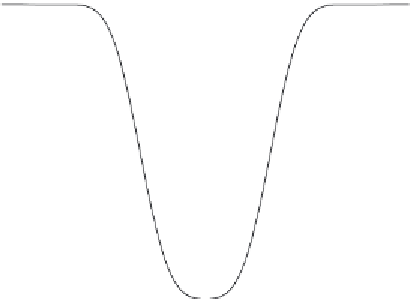Geology Reference
In-Depth Information
1.0
0.8
0.6
0.4
0.2
0
-0.003
-0.002
-0.001 0.0
Frequency in cycles per day
0.001
0.002
0.003
Figure 4.14 High-pass filter response for removal of spurious long-period
nutations.
In order to suppress potentially spurious long-period terms in the nutation resid-
uals, a high-pass filter was constructed by subtracting the convolution in the fre-
quency domain of a boxcar function
B
(
f
) and a Parzen frequency window,
P
(
f
),
given by expression (2.283), from an all-pass filter, giving the form
−
B
(
f
)
⊗
P
(
f
)
.
1
(4.110)
Filter parameters are chosen so that
the roll o
ff
for long periods begins at
±
490.6 days and is 90% complete at 1867 days. The response of the high-pass
filter is shown in Figure 4.14.
The discrete Fourier transform of each segment is subjected to this filter. The
overall spectral density estimate is given by the average over the four segments.
The logarithm of the power spectral density of the nutation residuals is plotted in
Figure 4.15 complete with the 95% confidence interval.
Two features stand out in the power spectrum of the nutation residuals. The first
is a retrograde resonance near
10
−
3
cycles per day. The second is a sim-
ilar, but somewhat smaller, prograde resonance near 2.6
−
2.4
×
10
−
3
cycles per day.
The retrograde resonance was first predicted by Poincare (1910) for a completely
fluid, incompressible core bounded by a rigid shell. In a variational calculation of
wobble-nutation modes in realistic Earth models, Jiang (1993) found not only the
classical retrograde free core nutation (RFCN) but also a prograde free core nuta-
tion (PFCN). He was able to find the RFCN in the spectrum of very long baseline
interferometry (VLBI) nutation observations well above the 95% confidence level,
but the PFCN could not be definitively identified due to the short length of the
VLBI record available at the time. Later, both modes were found in the VLBI
×



























Search WWH ::

Custom Search